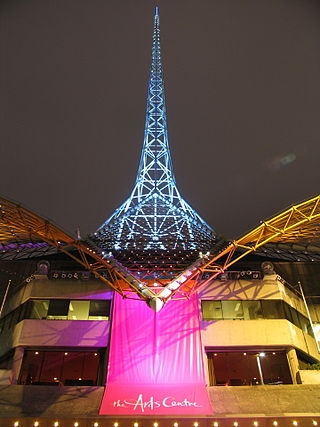
The National Gallery of Victoria, popularly known as the NGV, is an art museum in Melbourne, Victoria, Australia. Founded in 1861, it is Australia's oldest and most visited art museum.
The Melbourne Museum is a natural and cultural history museum located in the Carlton Gardens in Melbourne, Australia.

Arts Centre Melbourne, originally known as the Victorian Arts Centre and briefly called the Arts Centre, is a performing arts centre consisting of a complex of theatres and concert halls in the Melbourne Arts Precinct, located in the central Melbourne suburb of Southbank in Victoria, Australia.

Frankston is a suburb in Melbourne, Victoria, Australia, 41 km (25 mi) south-east of Melbourne's Central Business District, located within the City of Frankston local government area. Frankston recorded a population of 37,331 at the 2021 census.

The Melbourne Convention and Exhibition Centre (MCEC), colloquially referred to as Jeff's Shed, is a group of three adjacent buildings next to the Yarra River in South Wharf, an inner-city suburb of Melbourne, Victoria, Australia. The venues are owned and operated by the Melbourne Convention and Exhibition Trust.

The Living Arts Centre is a 225,000 sq ft (20,900 m2) multi-use facility which opened in Mississauga, Ontario, Canada, on October 7, 1997. The complex houses three theatres for the performing arts, Hammerson Hall, RBC Theatre and Rogers Theatre), an exhibition gallery, seven art studios and facilities for corporate meetings.

The Queensland Cultural Centre is a heritage-listed cultural center on Grey Street, South Brisbane, Queensland, Australia. It is part of the South Bank precinct on the Brisbane River and was built from 1976.

The Australian Centre For Contemporary Art (ACCA) is a contemporary art gallery in Melbourne, Australia. The gallery is located on Sturt Street in the Melbourne Arts Precinct, in the inner suburb of Southbank. Designed by Wood Marsh Architects, the building was completed in 2002, and includes facilities for Chunky Move dance company and the Malthouse Theatre.

The Lowry is a theatre and gallery complex at Salford Quays, Salford, Greater Manchester, England. It is named after the early 20th-century painter L. S. Lowry, known for his paintings of industrial scenes in North West England. The complex opened on 28 April 2000 and was officially opened on 12 October 2000 by Queen Elizabeth II.

The culture of Brisbane derives from mainstream Australian culture and incorporates a strong history in the performing arts, music and sport.
Sir Roy Burman Grounds was an Australian architect. His early work included buildings influenced by the Moderne movement of the 1930s, and his later buildings of the 1950s and 1960s, such as the National Gallery of Victoria and the adjacent Victorian Arts Centre, cemented his legacy as a leader in Australian architecture.

Adelaide Festival Centre, Australia's first capital city multi-purpose arts centre and the home of South Australia's performing arts, was built in the 1970s, designed by Hassell Architects. Located on Kaurna Yarta, the Festival Theatre opened in June 1973 with the rest of the centre following soon after. The complex includes Festival Theatre, Dunstan Playhouse, Space Theatre and several gallery and function spaces. Located approximately 50 metres (160 ft) north of the corner of North Terrace and King William Road, lying near the banks of the River Torrens and adjacent to Elder Park, it is distinguished by its two white geometric dome roofs, and lies on a 45-degree angle to the city's grid.

Monterey Secondary College is an Australian public, co-educational, secondary school, located in the City of Frankston suburb of Frankston North in Melbourne, Victoria.
Rone is the pseudonym of Tyrone Wright, an internationally renowned street artist based in Melbourne, Australia.

Canberra Theatre Centre (CTC), also known as the Canberra Theatre, is the Australian Capital Territory’s central performing arts venue and Australia's first performing arts centre, the first Australian Government initiated performing arts centre to be completed. It opened on 24 June 1965 with a gala performance by the Australian Ballet.


The culture of Melbourne, the capital of the Australian state of Victoria, encompasses the city's artistic, culinary, literary, musical, political and social elements. Since its founding as a British settlement in 1835, Melbourne has been culturally influenced by European culture, particularly that of the British Isles. During the 1850s Victorian gold rush and in the decades the immediately followed, immigrants from many other parts of the world, notably China and the Americas, helped shape Melbourne's culture. Over time, Melbourne has become the birthplace of a number of unique cultural traits and institutions, and today it is one of the world's most multicultural cities.

The Shanghai Oriental Art Center, abbreviated SHOAC, is one of the leading performance and cultural facilities in Shanghai. The five interconnected hemispherical halls or "petals" are shaped to resemble a butterfly orchid from above. They comprise the Entrance Hall, the Concert Hall, the Opera Hall, the Performance Hall, and the Exhibition Hall. The high-tech ceiling changes color during the night to reflect the nature of the performances inside. Located off Century Avenue in Pudong, the SHOAC was opened with a New Year's Eve concert in 2004 and officially opened on July 1, 2005.
The Daryl Chase Fine Arts Center is a multi-venue visual and performing arts complex on the campus of Utah State University. It is named for Daryl Chase, the tenth president of USU, who served from 1954 to 1968.

Metropolitan Meat Market, primarily known as Meat Market, in Melbourne, Australia, is a former market building that also incorporates the Metropolitan Hotel. It was designed by George Johnson and completed in 1874. It has been listed on the Victorian Heritage Register since 1973.

















